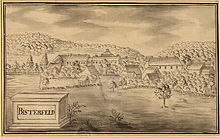Biesterfeld
The place Biesterfeld belongs as part of the district Rischenau to the city of Lügde in the North Rhine-Westphalian district of Lippe in Germany .
geography
location
Biesterfeld is located in the extreme southeast of the Lippe district, near the border with Lower Saxony , about eleven kilometers south of the city center of Lügde. The Schwalenberg Forest extends to the northwest , and the 495.8 m above sea level rises to the southeast . NHN high Köterberg .
history

According to the Falkenhagen monastery register of 1529, Biesterfeld was described as a settlement near Rischenau with several farms and two large farmyards .
In the first half of the 17th century, Count Simon VI. to the lip this to the "Meierei Biesterfeld". In 1624 Count Simon VII zu Lippe handed over the dairy to Simon von der Lippe, the bailiff in Schwalenberg .
In 1624 Countess Maria Magdalena, the widow of Simon VII, bought the dairy for 6,000 thalers . Her son, Jobst Hermann zur Lippe , owner of the Paragialamt (= compensation with real estate) in Schwalenberg , expanded the Biesterfeld manor on the dairy farm from 1678 . In 1740 the distillery and the brewery were built. From 1764 Biesterfeld became the domain of the counts.
Jobst Hermann is considered the lord of the hereditary count line to Lippe-Biesterfeld .
After a severance payment, the last man on Biesterfeld, Friedrich Karl August (Lippe), left Biesterfeld with his family in 1772 and moved to Gut Oberkassel near Bonn ( Lippesches Landhaus ) and later - in the middle of the 19th century - to Bentschen in the province of Posen . After disputes about the succession after the extinction of the Detmold line of the House of Lippe, a higher authority decided in favor of the Lippe-Biesterfeld line, and they returned to their home country and took over the reign of the Principality of Lippe in 1897 . Leopold IV was the last prince to abdicate in 1918. Bernhard zur Lippe-Biesterfeld , known as Prince Consort Bernhard of the Netherlands, is a nephew of Leopold IV.
The count's castle in Biesterfeld was demolished around 1820.
Until 1848 the local connection route from Rischenau to Löwendorf ran through it, only with the construction of today's federal highway 239 in 1847/48 as Chausseestrasse did the settlement lose its character as a transit point.
In 1850, the chance seedling of an apple variety described as very tasty was discovered on the former castle grounds , which was named after its place of discovery Biesterfelder Renette . It was first described in 1904 by Pastor Wilhelm Wilms from Nieheim , who spread it further and made it known nationwide. One of the oldest trees is still growing in the orchard at the western entrance to the Paradiesmühle .
Attractions
Buildings
From the former manor in Lippe-Biesterfeld, only five buildings still exist today:
- The old distillery with the brewery was built in 1740 by Friedrich Karl August (Lippe). The brewery has only been partially preserved after a major fire and was rebuilt in 1998 as a riding hall. Well-preserved cross vaults on the ground floor of the house were torn down. On the east side of the house is a relief in memory of Princess Pauline zur Lippe , one of the most important rulers of the Principality of Lippe.
- The former forester's house (formerly residential house) of the Biesterfeld domain was built around 1820 in place of the castle of the Counts of Biesterfeld that had been broken down. The old cellar vault of the castle is still in the house. Right in front of the house is a 700-year-old linden tree, the "Marienlinde", one of the oldest in Germany.
- Mägdehaus , located behind the forester's house
- The so-called Rappelkrug was probably built around 1724 (the year of construction is assumed, but has not yet been used) by Johann Bernd Deppe as a residential building. In September 1735, Friedrich Carl August, Count and Noble Herr zur-Lippe-Biesterfeld, bought the house from his former valet and personal hunter and set up a tavern. He gave this the name "Rappelkrug". On March 15, 1763, it was given as a gift from Friedrich Karl August (Lippe) to Johann Jost Gnade, this is mentioned in a document. He lost his mug rights . Today the building is privately owned. Thus it only functioned as a jug from 1735 to early 1763.
- The Paradiesmühle , a former mill at Biesterfeld (now located on the outskirts of Rischenau), now houses adventure gastronomy and a mill museum.
Individual evidence
- ↑ Willy Gerking: Niese - the story of a Lippe village . Pages 31-34. 1979
- ↑ Old types of fruit - The Biesterfelder Renette. In: Luegde.de. 2013, accessed February 11, 2018 .
Coordinates: 51 ° 52 ' N , 9 ° 16' E
